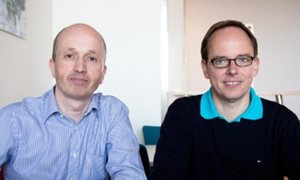28 August 2018
Correlative light and electron microscopy (CLEM) was so far performed using conventional light microscopy (LM) and EM. Although this offered unique and complementary information from the same cell or tissue sample, the interpretation of those correlative images was challenged by the fact that the lateral resolution of conventional LM (~250 nm) is much worse than the lateral resolution of EM (~2 nm), something referred to as the “resolution gap”. The correlative imaging pipeline developed by the research team at the Radboudumc, called SR-CLEM, narrows this gap as it combines the ultrastructure provided by EM with super-resolved fluorescent images by Airyscan imaging (lateral resolution ~140 nm). Ben Joosten and Koen van den Dries used SR-CLEM to study the nanoscale architecture of podosomes, small cytoskeletal structures used by leukocytes to transmigrate basement membranes or by osteoclasts to remodel bone tissue, and published their results in Frontiers in Immunology, the most-cited open-access journal in the JCR category of Immunology.
“With the recent development of a fully customized home-built Stochastic Optical Reconstruction Microscope (STORM, lateral resolution ~10 nm), we aim at further bridging the resolution gap by correlating STORM with SEM” says Alessandra Cambi (head of the department of Cell Biology).
Jack Fransen (MIC manager) highlights that SR-CLEM is now available to all researchers within the Radboudumc. This approach is particularly interesting for elucidating the organization of complex multimolecular cellular structures as well as for characterizing microorganisms, nanomaterials or nanoparticles and their interaction with cells. If researchers want to integrate correlative imaging in their research or have information requests, they can contact the MIC.
 Researchers from the Dept. of Cell Biology, theme Nanomedicine, and the ‘Microscopy Imaging Center’ (MIC, a Radboudumc Technology Center) recently developed and optimized a pipeline for correlative imaging using super-resolution (SR) microscopy and scanning electron microscopy (SEM).
Researchers from the Dept. of Cell Biology, theme Nanomedicine, and the ‘Microscopy Imaging Center’ (MIC, a Radboudumc Technology Center) recently developed and optimized a pipeline for correlative imaging using super-resolution (SR) microscopy and scanning electron microscopy (SEM).
Correlative light and electron microscopy (CLEM) was so far performed using conventional light microscopy (LM) and EM. Although this offered unique and complementary information from the same cell or tissue sample, the interpretation of those correlative images was challenged by the fact that the lateral resolution of conventional LM (~250 nm) is much worse than the lateral resolution of EM (~2 nm), something referred to as the “resolution gap”. The correlative imaging pipeline developed by the research team at the Radboudumc, called SR-CLEM, narrows this gap as it combines the ultrastructure provided by EM with super-resolved fluorescent images by Airyscan imaging (lateral resolution ~140 nm). Ben Joosten and Koen van den Dries used SR-CLEM to study the nanoscale architecture of podosomes, small cytoskeletal structures used by leukocytes to transmigrate basement membranes or by osteoclasts to remodel bone tissue, and published their results in Frontiers in Immunology, the most-cited open-access journal in the JCR category of Immunology.
“With the recent development of a fully customized home-built Stochastic Optical Reconstruction Microscope (STORM, lateral resolution ~10 nm), we aim at further bridging the resolution gap by correlating STORM with SEM” says Alessandra Cambi (head of the department of Cell Biology).
Jack Fransen (MIC manager) highlights that SR-CLEM is now available to all researchers within the Radboudumc. This approach is particularly interesting for elucidating the organization of complex multimolecular cellular structures as well as for characterizing microorganisms, nanomaterials or nanoparticles and their interaction with cells. If researchers want to integrate correlative imaging in their research or have information requests, they can contact the MIC.
Related news items

Prinses Beatrix Spierfonds grant to investigate patient stratification in myotonic dystrophy
24 January 2020 RIMLS researchers Rick Wansink and Roland Brock, both theme Nanomedicine, received a € 280,000 grant from the Prinses Beatrix Spierfonds. go to page
'Stofwisselkracht' grant for Paola de Haas and Alessandra Cambi
5 December 2019 Paola de Haas and Alessandra Cambi, theme Nanomedicine, have recently been awarded a grant from ‘Stichting Stofwisselkracht’ for their project entitled “Identification of immune-related symptoms in Congenital Disorders of Glycosylation”. go to page
Podosome nanoscale architecture redefined
20 November 2019 Koen van den Dries and Alessandra Cambi, theme Nanomedicine, revealed how the nanoscale architecture of podosomes enables dendritic cells to protrude and sense their extracellular environment. They have published their results in Nature Communications. go to page
MMD Lecturer of the year award for Alessandra Cambi
16 September 2019 At their annual MMD symposium, Alessandra Cambi, theme Nanomedicine, was chosen as lecturer of the year 2018-2019 of the Top Master "Molecular mechanisms of disease". go to page
Patient trust and participation in cell biological research
21 August 2019 Alessandra Cambi and Gert Olthuis discuss key ethical issues inherent in the development and the value of building trust and trustworthiness. go to page
